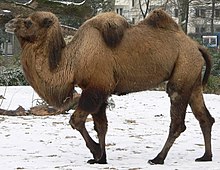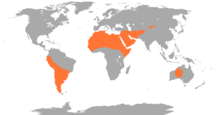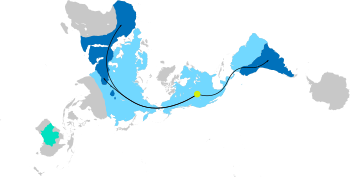Camelidae
| Camelidae | |
|---|---|

| |
| ABactrian camelwalking in snow | |
| Scientific classification | |
| Domain: | Eukaryota |
| Kingdom: | Animalia |
| Phylum: | Chordata |
| Class: | Mammalia |
| Order: | Artiodactyla |
| Suborder: | Tylopoda |
| Superfamily: | Cameloidea |
| Family: | Camelidae Gray,1821 |
| Type genus | |
| Camelus | |
| Subfamilies | |

| |
| Current range of camelids, all species | |
Camelidsare members of the biologicalfamilyCamelidae,the only currently living family in the suborderTylopoda.The sevenextantmembers of this group are:dromedary camels,Bactrian camels,wild Bactrian camels,llamas,alpacas,vicuñas,andguanacos.Camelids areeven-toed ungulatesclassified in theorderArtiodactyla,along with species includingwhales,pigs,deer,cattle,andantelopes.
Characteristics
[edit]
Camelids are large, strictlyherbivorousanimals with slender necks and long legs. They differ fromruminantsin a number of ways.[2]Their dentition show traces of vestigial centralincisorsin theincisive bone,and the third incisors have developed into canine-like tusks. Camelids also have truecanine teethand tusk-likepremolars,which are separated from themolarsby a gap. As in ruminants, the upper incisors are largely absent and are replaced by adental padconsisting of connective tissue covered withepithelium.[3]The musculature of the hind limbs differs from those of other ungulates in that the legs are attached to the body only at the top of the thigh, rather than attached by skin and muscle from the knee upwards. Because of this, camelids have to lie down by resting on their knees with their legs tucked underneath their bodies.[1]They have three-chamberedstomachs,rather than four-chambered ones; their upper lips are split in two, with each part separately mobile; and, uniquely among mammals, theirred blood cellsare elliptical.[2]They also have a unique type ofantibodies,which lack the light chain, in addition to the normal antibodies found in other mammals. These so-calledheavy-chain antibodiesare being used to developsingle-domain antibodieswith potentialpharmaceuticalapplications.
Camelids do not have hooves; rather, they have two-toed feet with toenails and soft foot pads (Tylopodais Greek for "padded foot" ). Most of the weight of the animal rests on these tough, leathery sole pads. The South American camelids have adapted to the steep and rocky terrain by adjusting the pads on their toes to maintain grip.[4]The surface area of Camels foot pads can increase with increasing velocity in order to reduce pressure on the feet and larger members of the camelid species will usually have larger pad area, which helps to distribute weight across the foot.[5]Many fossil camelids wereunguligradeand probably hooved, in contrast to all living species.[6]
Camelids are behaviorally similar in many ways, including their walking gait, in which both legs on the same side are moved simultaneously. While running, camelids engage a unique "running pace gait" in which limbs on the same side move in the same pattern they walk, with both left legs moving and then both right, which ensures that the fore and hind limb will not collide while in fast motion. During this motion, all four limbs momentarily are off the ground at the same time.[7]Consequently, camelids large enough for human beings to ride have a typical swaying motion.
Dromedary camels, bactrian camels, llamas, and alpacas are allinduced ovulators.[8]
The three Afro-Asian camel species have developed extensive adaptations to their lives in harsh, near-waterless environments. Wild populations of the Bactrian camel are even able to drinkbrackish water,and some herds live in nuclear test areas.[9]
Comparative table of the seven extant species in the family Camelidae:
| Species | Image | Natural range | Weight | ||||||
|---|---|---|---|---|---|---|---|---|---|
| Camelus | |||||||||
| Bactrian camel
(Camelus bactrianus) |

|
CentralandInner Asia (entirely domesticated) |
300 to 1,000 kg (660 to 2,200 lb) | ||||||
| Dromedary or Arabian camel (Camelus dromedarius) |

|
South Asia and Middle East (entirely domesticated) |
300 to 600 kg (660 to 1,320 lb) | ||||||
| Wild Bactrian camel
(Camelus ferus) |

|
China and Mongolia | 300 to 820 kg (660 to 1,800 lb) | ||||||
| Lama | |||||||||
| Llama
(Lama glama) |

|
(domestic form of guanaco) | 130 to 200 kg (290 to 440 lb) | ||||||
| Guanaco
(Lama guanicoe) |

|
South America | about 90 to 120 kg (200 to 260 lb) | ||||||
| Alpaca
(Lama pacos) |

|
(domestic form of vicuña) | 48 to 84 kg (106 to 185 lb) | ||||||
| Vicuña
(Lama vicugna) |

|
South AmericanAndes | 35 to 65 kg (77 to 143 lb) | ||||||
Evolution
[edit]| A family tree indicating different species within the Camelidae family[10] |

Camelids are unusual in that their modern distribution is almost the inverse of their area of origin. Camelids first appeared very early in the evolution of the even-toed ungulates, around 50 to 40 million years ago during the middleEocene,[citation needed]in present-day North America. Among the earliest camelids was the rabbit-sizedProtylopus,which still had four toes on each foot. By the lateEocene,around 35 million years ago, camelids such asPoebrotheriumhad lost the two lateral toes, and were about the size of a moderngoat.[6][11]
The family diversified and prospered, with the two living tribes, theCameliniandLamini,diverging in the late earlyMiocene,about 17 million years ago, but remained restricted to North America until about 6 million years ago, whenParacameluscrossed theBering land bridgeintoEurasia,giving rise to the modern camels, and about 3-2 million years ago, whenHemiaucheniaemigrated into South America (as part of theGreat American Interchange), giving rise to the modern llamas.[citation needed]A population ofParacameluscontinued living in North America and evolved into thehigh arctic camel,which survived until the middle Pleistocene.
The original camelids of North America remained common until the quite recent geological past, but then disappeared, possibly as a result of hunting or habitat alterations by theearliest human settlers,and possibly as a result of changing environmental conditions after the last ice age, or a combination of these factors. Three species groups survived - thedromedaryof northern Africa and southwest Asia; theBactrian camelof central Asia; and the South American group, which has now diverged into a range of forms that are closely related, but usually classified as four species -llamas,alpacas,guanacos,andvicuñas.Camelids were domesticated by early Andean peoples,[12]and remain in use today.
Fossil camelids show a wider variety than their modern counterparts. One North American genus,Titanotylopus,stood 3.5 m at the shoulder, compared with about 2.0 m for the largest modern camelids. Other extinct camelids included small, gazelle-like animals, such asStenomylus.Finally, a number of very tall, giraffe-like camelids were adapted to feeding on leaves from high trees, including such genera asAepycamelusandOxydactylus.[6]
Whether the wild Bactrian camel (Camelus ferus) is a distinct species or a subspecies (C. bactrianus ferus) is still debated.[13][14]The divergence date is 0.7 million years ago, long before the start of domestication.[14]
Scientific classification
[edit]

Family Camelidae
- †SubfamilyPoebrotheriinae
- †SubfamilyMiolabinae
- †SubfamilyStenomylinae
- †SubfamilyFloridatragulinae
- SubfamilyCamelinae
- TribeLamini
- Genus:Lama
- Genus:Hemiauchenia
- GenusPalaeolama
- TribeCamelini
- Genus:Camelus
- Bactrian camel,Camelus bactrianus
- Dromedary,Camelus dromedarius
- Wild Bactrian camel,Camelus ferus
- †Syrian camel,Camelus moreli
- †Camelus sivalensis
- †Camelus knoblochi
- Genus:Camelops
- Genus:Paracamelus
- Genus:Camelus
- TribeLamini
Phylogeny
[edit]| Camelid ancestor |
| |||||||||||||||||||||||||||||||||||||||||||
Extinct genera
[edit]| Genus name | Epoch | Remarks |
|---|---|---|
| Aepycamelus | Miocene | Tall, s-shaped neck, true padded camel feet |
| Aguascalientia[24] | EarliestMiocene | A small, primitive, narrow-snouted floridatraguline camel from Mexico, Texas, and Panama |
| Camelops | Pliocene-Pleistocene | Large, with true camel feet and hump. Status uncertain |
| Eulamaops | Pleistocene | FromSouth America |
| Floridatragulus | EarlyMiocene | An unusual species of camel with a long snout |
| Hemiauchenia | Miocene-Pleistocene | A North and South American lamine genus |
| Megatylopus | Miocene-EarlyPleistocene | Large camelid fromNorth America |
| Megacamelus | Miocene-Pleistocene | The largest species of camelid |
| Michenia | Early-MiddleMiocene | A cameline that existed for 10 million years in North America |
| Oxydactylus | EarlyMiocene | The earliest member of the "giraffe camel" family |
| Palaeolama | Pleistocene | A North and South American lamine genus |
| Poebrotherium | Oligocene | This species of camel took the place of deer and antelope in the White RiverBadlands. |
| Procamelus | Miocene | Ancestor of extinctTitanolypusand modernCamelus |
| Protylopus | LateEocene | Earliest member of the camelids |
| Stenomylus | EarlyMiocene | Small, gazelle-like camel that lived in large herds on the Great Plains |
| Stevenscamelus[24] | LateEocene | Long-snouted primitive relative ofFloridatragulus |
| Titanotylopus | Miocene-Pleistocene | Tall, humped, true camel feet |
International Year of Camelids
[edit]In October 2017 theUnited Nationsdeclared 2024 to be theInternational Yearof Camelids in order to show how camelids are important for food security, economics and culture for manypastoralcommunities.[25][26][27][28]
References
[edit]- ^abClutton-Brock, Juliet (1987).A Natural History of Domesticated Mammals.Cambridge University Press. p. 208.ISBN978-0-521-34697-9.
- ^abFowler, M.E. (2010).Medicine and Surgery of Camelids,Ames, Iowa: Wiley-Blackwell. Chapter 1 "General Biology and Evolution" addresses the fact that camelids (including camels and llamas) are not ruminants, pseudo-ruminants, or modified ruminants.
- ^Niehaus, Andrew (2022),"Tooth Root Abscess",Comparative Veterinary Anatomy,Elsevier, pp. 1013–1019,doi:10.1016/b978-0-323-91015-6.00089-3,ISBN978-0-323-91015-6,retrieved2023-10-29
- ^Franklin, William (1984). Macdonald, D. (ed.).The Encyclopedia of Mammals.New York: Facts on File. pp.512–515.ISBN978-0-87196-871-5.
- ^Clemente, Christofer J.; Dick, Taylor J. M.; Glen, Christopher L.; Panagiotopoulou, Olga (2020-03-02)."Biomechanical insights into the role of foot pads during locomotion in camelid species".Scientific Reports.10(1): 3856.Bibcode:2020NatSR..10.3856C.doi:10.1038/s41598-020-60795-9.ISSN2045-2322.PMC7051995.PMID32123239.
- ^abcSavage, RJG; Long, MR (1986).Mammal Evolution: an illustrated guide.New York: Facts on File. pp.216–221.ISBN978-0-8160-1194-0.
- ^Janis, Christine M.; Theodor, Jessica M.; Boisvert, Bethany (2002-03-14)."Locomotor evolution in camels revisited: a quantitative analysis of pedal anatomy and the acquisition of the pacing gait".Journal of Vertebrate Paleontology.22(1): 110–121.doi:10.1671/0272-4634(2002)022[0110:LEICRA]2.0.CO;2.ISSN0272-4634.S2CID86174860.
- ^Chen, B.X.; Yuen, Z.X. & Pan, G.W. (1985)."Semen-induced ovulation in the bactrian camel (Camelus bactrianus)"(PDF).J. Reprod. Fertil.74(2): 335–339.doi:10.1530/jrf.0.0740335.PMID3900379.RetrievedSeptember 12,2014.
- ^Wild Bactrian Camels Critically Endangered, Group SaysNational Geographic, 3 December 2002
- ^"Animal Diversity Web." ADW: Camelidae: CLASSIFICATION. N.p., n.d. Web. 09 June 2017.
- ^Palmer, D., ed. (1999).The Marshall Illustrated Encyclopedia of Dinosaurs and Prehistoric Animals.London: Marshall Editions. pp. 274–277.ISBN978-1-84028-152-1.
- ^Moore, Katherine M. (2016). "Early Domesticated Camelids in the Andes". In Capriles, Jose M.; Tripcevich, Nicholas (eds.).The Archaeology of Andean Pastoralism.University of New Mexico Press.ISBN978-0-8263-5702-1.
- ^Cui, Peng; Ji, Rimutu; Ding, Feng; Qi, Dan; Gao, Hongwei; Meng, He; Yu, Jun; Hu, Songnian; Zhang, Heping (2007-07-18)."A complete mitochondrial genome sequence of the wild two-humped camel (Camelus bactrianus ferus): an evolutionary history of camelidae ".BMC Genomics.8(1): 241.doi:10.1186/1471-2164-8-241.ISSN1471-2164.PMC1939714.PMID17640355.
- ^abJi, R.; Cui, P.; Ding, F.; Geng, J.; Gao, H.; Zhang, H.; Yu, J.; Hu, S.; Meng, H. (2009-08-01)."Monophyletic origin of domestic bactrian camel (Camelus bactrianus) and its evolutionary relationship with the extant wild camel (Camelus bactrianus ferus) ".Animal Genetics.40(4): 377–382.doi:10.1111/j.1365-2052.2008.01848.x.ISSN1365-2052.PMC2721964.PMID19292708.
- ^"Paleobiology Database -Hemiaucheniabasic info ".Archived fromthe originalon 2021-02-13.Retrieved2020-06-29.
- ^Paleobiology Database -Palaeolamabasic info
- ^Paleobiology Database -Blancocamelusbasic info
- ^Paleobiology Database -Pleiolamabasic info
- ^Paleobiology Database -Camelopsbasic info
- ^Paleobiology Database -Paracamelusbasic info
- ^Geraads, Denis; Didier, Gilles; Barr, Andrew; Reed, Denne; Laurin, Michel (April 2020)."The fossil record of camelids demonstrates a late divergence between Bactrian camel and dromedary=Acta Palaeontologica Polonica".Acta Palaeontologica Polonica.65(2): 251–260.doi:10.4202/app.00727.2020.eISSN1732-2421.ISSN0567-7920.
- ^Database -Procamelusbasic info
- ^Database -Hesperocamelusbasic info
- ^abProthero, D.R.; Beatty, B.L.; Marriott, K. (September 2023)."Systematics of the long-nosed Floridatraguline camels (Artiodactyla: Camelidae)".Fossil Record.9(94): 533–545.Retrieved18 December2023.
- ^Adarsh Kumar Gupta."Why UN has declared 2024 the International Year Of Camelids".Hindustan Times News.
- ^"Kingdom Launches International Year of Camelids (IYC 2024)".spa.gov.sa.Retrieved2024-06-11.
- ^"UN Declares 2024 As Year Of Camelids. Here's Why".NDTV.com.Retrieved2024-06-11.
- ^"International Year of Camelids (IYC) 2024".Food and Agriculture Organization of the United Nations.Retrieved2024-06-11.
